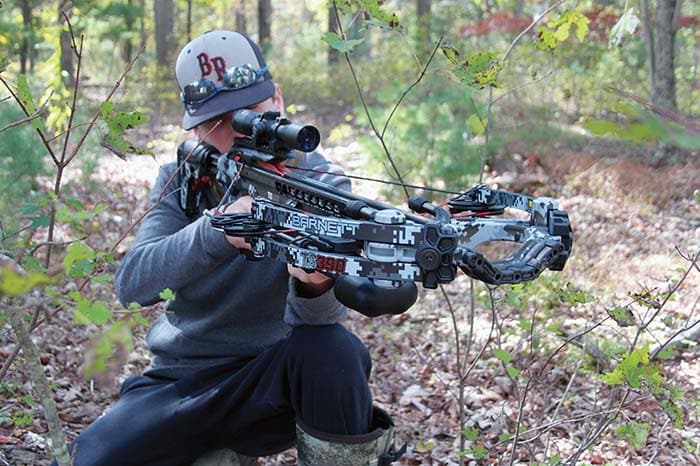By J.M. Ramos

Over the years, there have been countless articles written about Marlin’s popular rimfire self-loaders starting with the Model 99 (M99) originally designed by Ewald Nichol. The M99 family soon expanded to about a dozen variations along with its econoline brand, the Glenfield. A refined version of the M99 was introduced in 1967 which was soon to be known as the Marlin Model 60, the gun that virtually outsold every other .22 semi-auto, magazine or tubular feed combined. In 1964, Bill Ruger introduced what became the main rival of Marlin’s bread and butter, the 1022. Ruger’s little carbine became an instant success. Although it holds the title as the world’s most popular .22 semi-auto with possibly between 5 to 6 million sold to date, it is the Marlin Model 60 that possesses the crown jewel as the best-selling .22 autoloader of all time with over 11 million guns sold—almost double the 1022’s overall sales record.
Exploring the Marlin
For nearly 15 years, my nickel-finish Papoose was collecting dust in the safe and was almost forgotten while I had been busy dressing up the 1022. Then one day I finally got bored with the Ruger and decided to check on the old Marlin. After long thought, the urge to sizzle a sleeper took over. The Marlin, being ignored for so long, suddenly became a point of interest. By taking advantage of its already amazing accuracy from its 16 micro-groove rifling (developed by Marlin in 1953) and a sound mechanical design, all it really needed now was a modern make-over from aesthetics down to ergonomics. In other words, I wanted to make it a winner by elevating its status from being a casual plinker to an adorable, extraordinary tack-driver. Independent accessory producers should start taking a close look at the Papoose for its money-making potential. So much focus has been given to the Ruger 1022 over the years that it has virtually saturated the market with not much left to be done to it. The take-down Marlin, on the other hand, is fresh for exploration. Given the proper facelift, it could be the next big thing on the horizon.
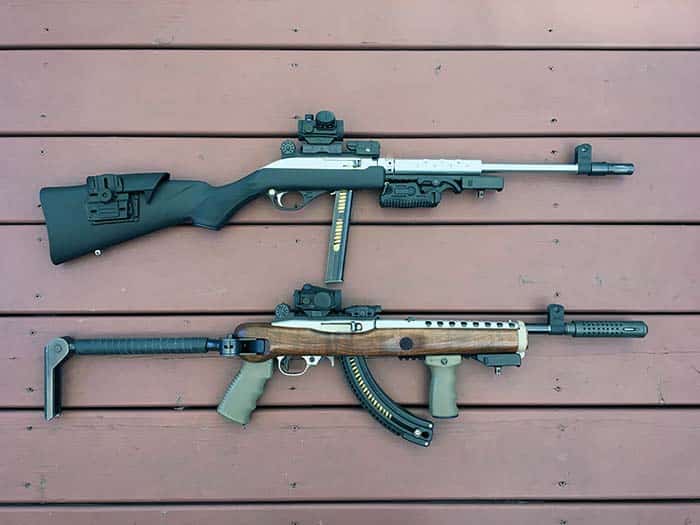
The Papoose debuted in 1986. Its action is based on the original M70 (currently listed as M795). In 1993, an updated version of the Papoose, the M70 PSS, was introduced featuring a last-round magazine hold-open device. The trigger lock work of the Papoose (as well as its other semi-auto siblings) has been well-established in the past 50-plus years, but that doesn’t mean there’s no room for improvement.
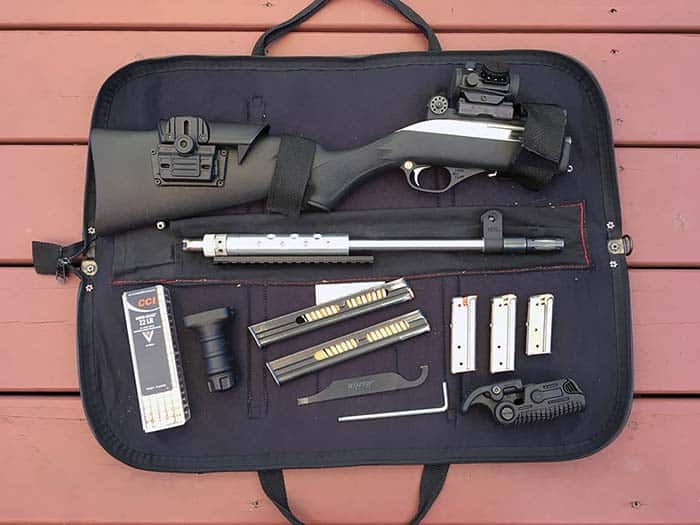
Improving the Papoose
There are several areas that need refinements to further improve the Papoose that can also benefit its siblings—primarily those that improve the trigger pull and assembly simplification. The hammer let off of the gun itself is excellent and has a very fast lock time. However, the problem lies in the positioning of the trigger in relation to the sear bar that trips the hammer when the trigger is pulled. These two critical parts are assembled into two separate units instead of one, creating an inconsistent gap which normally results in trigger slack or non-uniform trigger pull and poor re-set. To correct this, an adjustment screw must be installed to the trigger section that is directly in contact with the sear. This simple remedy improves the trigger pull considerably with faster re-set by simply adjusting the set screw to lessen the gap between the two parts. Ideally, the side plates of the trigger module should have made room to accommodate the trigger assembly rather than on the trigger guard. With the trigger assembled to the same housing with the hammer and sear assembly, the engagement between the trigger and sear bar is more consistent and precise. This arrangement will only require one piece of stock with an integral trigger guard minimizing the number of parts and providing faster assembly and disassembly. In addition, the trigger guard is subject to breaking at its hold-open assembly slot and front end screw assembly hole.
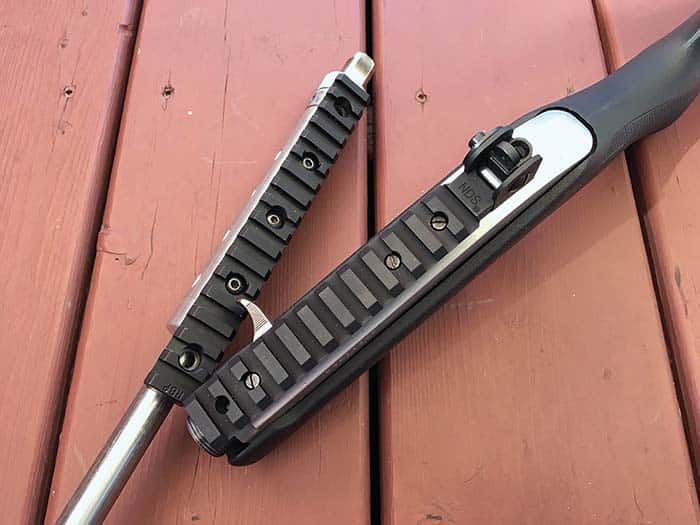
Another noted area that requires attention is the assembly pin. This is the part that connects the side plate assembly to the rear of the receiver. This part is made of polymer material. Over time, this part will wear out and will cause some looseness in the side plate assembly thus creating unnecessary movement that affects both the trigger pull and feeding sequence during gun cycle. Replacing the plastic pin with a steel rod is the best solution, and you will never have to buy another one again. The diameter of the side plate holes is slightly larger than the receiver hole where this pin is assembled. Therefore, the steel pin is turned to two-step diameter to fit both the holes of the side plate (one side only) and the receiver hole. Both ends of the pin are secured by “C” clips to keep the plates tightly secured in place. The clips must squeeze the side plates tight when assembled to the receiver to assure tight mating of the upper and lower parts. This basic improvement further lightened and improved the consistency of the trigger pull but also improved overall reliability as well.

Another area that needs improvement is the firing pin. This part is subject to breakage if the gun is dry-fired consistently. It appears too thin and fragile. Thickness must be doubled, and better heat treatment must be undertaken to allow dry firing when adjusting trigger pull or practice.
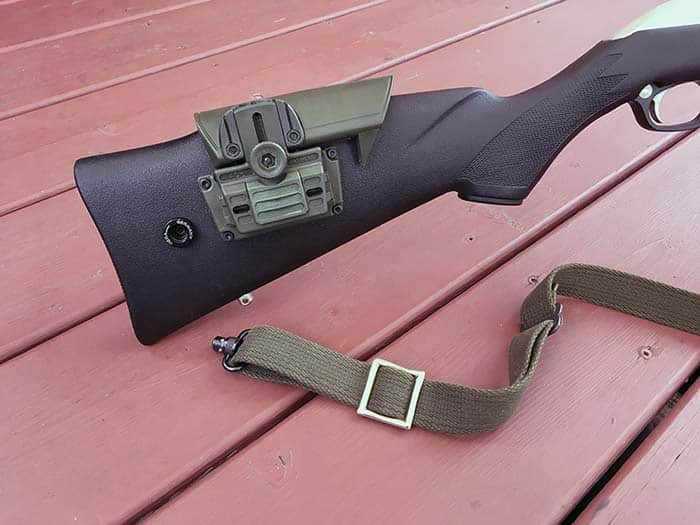
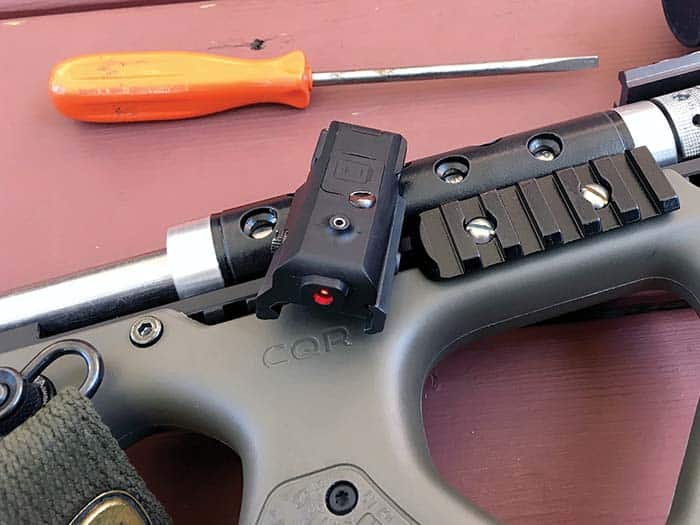
Maximizing Accuracy
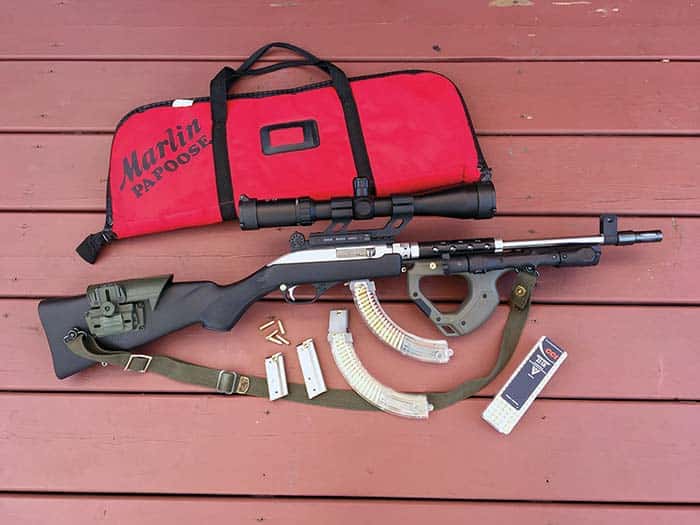
To maximize the inherent accuracy of the Papoose to its highest level with the use of an iron sight, the standard factory sight must be replaced with a GI style, which offers excellent sight picture, precise windage and elevation adjustments and has the provision to accept an assortment of modern optics (red dots and scopes) via a built-in Picatinny rail. Unfortunately, the ideal sight I am looking for is not yet available for this gun, except for one without an integral rail made by Tech-Sights. The good news is, after a brief tinkering, it was determined that the NoDak Spud 1022 sight set can be adapted perfectly to the Papoose. The rear radius of both the Marlin and Ruger receivers are quite identical, with the Ruger being slightly wider. Installing the NDS-26 railed rear sight to the Papoose only required drilling and tapping three holes (6X48 TPI) at the middle of the serrated scope mount in line with the holes of the railed sight. The matching front sight (NDS-44) has a .610-inch inside diameter slightly larger than the skinny, slightly tapered barrel of the project gun. This will require a shim with .500 I.D. and .610 O.D with the same length as the sight itself. The shim will be slit to allow it to open a bit while inserting and sliding it to the barrel where it would seat (a turned section of the barrel .500 O.D.). The shim can be made from heat resistant plastic or steel tubing for flexibility. Surprisingly, although the NDS sights are made for the 1022, they co-witness perfectly and produce amazing accuracy with CCI Mini-Mags, the only ammo used in the test that performed flawlessly with the magazines used.

Dress up the Papoose
To complement its superb NDS sight, it is fitting to give the improved Papoose a better image—something pleasant to look at with enhanced ergonomics and user friendliness. As it is, the take-down rifle lacks the ergonomics for instinctive shooting with the absence of a forearm. Aiming is a bit awkward if not backward primarily to those who embrace the modern way of shooting a rifle with a stretched arm grasping the front end of the forearm. To improve its practicality, a 1-inch diameter, 6-inch ventilated aluminum forearm that can accommodate a short or long Picatinny rail was added where assortments of tactical accessories can be mounted such as vertical grip, laser or bipod. For foregrip, the Hera Arms P90 style grip was selected for its ultra-modern styling and comfort. A mini rail was added to the left side of the grip where a micro-laser or light can be readily mounted for night application. To accommodate a medium to high optic mounting to clear the rear sight when using a full-size scope for long-range shooting, the versatile CAA CBS adjustable stock rest was added to the stock to provide the necessary cheek rest elevation. The upgraded gun complete with small red dot scope can be taken down in the usual manner and can still fit inside the Papoose nylon case. However, the barrel can no longer be stored in its usual pocket without detaching the Hera grip from it. Should you opt to carry the gun as a conventional rifle, Hera Arms’ ambi-quick detach swivel mount mounted at the rear of the stock is a perfect match for the P90 front grip accessory. An issue M1 Carbine sling mated to Uncle Mike’s QD sling swivel complements the Hera hardware nicely.
Needless to say, this special project yielded great results proving that this goofy little plinker has a lot more to offer than it actually looks when given the proper attire and equipment. It has definitely met or even exceeded my expectation in the quest to create a marvelous take-down companion with a tack-driving accuracy to back it up.
SOURCES
marlinfirearms.com
nodakspud.com
hera-arms.de
commandarms.comshootersridge.com
cci-ammunition.com
| This article first appeared in Small Arms Review V23N4 (April 2019) |





